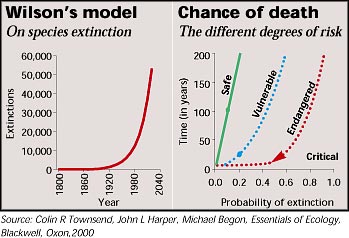The face of extinction
 The story of tiny Easter Island in the Pacific Ocean is the perfect parable for extinction. This 64 square mile island had fertile soil and a mild climate. Humans settled here in 400 ad and according to archaeologists, their numbers reached as high as 20,000. But when Dutch travellers reached there in 1722, found a grassy wasteland with hundreds of very large sculptures strewn all over. What had happened?
The story of tiny Easter Island in the Pacific Ocean is the perfect parable for extinction. This 64 square mile island had fertile soil and a mild climate. Humans settled here in 400 ad and according to archaeologists, their numbers reached as high as 20,000. But when Dutch travellers reached there in 1722, found a grassy wasteland with hundreds of very large sculptures strewn all over. What had happened?
At its peak, Easter Islands' dense forests had hundreds of massive endemic palms. The islanders used these trees to make fishing boats and to drag, position and erect the huge sculptures the Dutch travellers saw. Soon, the islanders had cut one palm too many; available trees had shrunk to stumps. Unable to make canoes, they stopped going to the sea. By 1400 ad, fishing stopped. The people began eating the island's animals: porpoises, seabirds, land birds, rats and seals. The delicacies were cooked in ovens fired by wood from the forests. As meals increased, animals and forests vanished. The disappearance of birds bought pollination to a halt. Then, cannibalism became the islander's only option. They ate and killed each other and turned the island bare again in just 1,400 years. The Easter Islands' palm tree now sits inside a museum
Related Content
- Order of the National Green Tribunal regarding endangered feral horses in Dibru-Saikhowa National Park, Assam, 16/12/2024
- State of the world’s migratory species
- State of finance for nature 2022
- Summary for policymakers of the thematic assessment of the sustainable use of wild species
- Climate change 2022: impacts, adaptation and vulnerability
- Powering nature: creating the conditions to enable nature-based solutions
